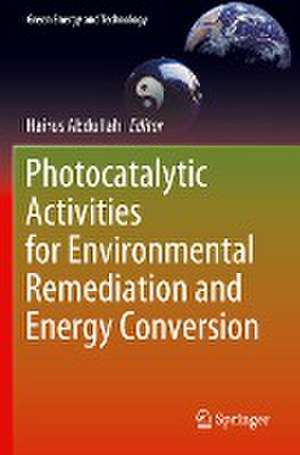Photocatalytic Activities for Environmental Remediation and Energy Conversion: Green Energy and Technology
Editat de Hairus Abdullahen Limba Engleză Paperback – 21 oct 2023
| Toate formatele și edițiile | Preț | Express |
|---|---|---|
| Paperback (1) | 399.03 lei 38-44 zile | |
| Springer Nature Singapore – 21 oct 2023 | 399.03 lei 38-44 zile | |
| Hardback (1) | 648.24 lei 3-5 săpt. | |
| Springer Nature Singapore – 20 oct 2022 | 648.24 lei 3-5 săpt. |
Din seria Green Energy and Technology
- 18%
 Preț: 943.43 lei
Preț: 943.43 lei - 20%
 Preț: 629.52 lei
Preț: 629.52 lei - 18%
 Preț: 1124.92 lei
Preț: 1124.92 lei - 18%
 Preț: 947.35 lei
Preț: 947.35 lei - 15%
 Preț: 655.92 lei
Preț: 655.92 lei - 18%
 Preț: 957.62 lei
Preț: 957.62 lei - 18%
 Preț: 789.52 lei
Preț: 789.52 lei - 17%
 Preț: 464.56 lei
Preț: 464.56 lei - 15%
 Preț: 645.79 lei
Preț: 645.79 lei - 18%
 Preț: 903.93 lei
Preț: 903.93 lei - 24%
 Preț: 1322.09 lei
Preț: 1322.09 lei - 18%
 Preț: 890.54 lei
Preț: 890.54 lei - 18%
 Preț: 1115.46 lei
Preț: 1115.46 lei - 18%
 Preț: 1117.03 lei
Preț: 1117.03 lei - 18%
 Preț: 949.73 lei
Preț: 949.73 lei - 18%
 Preț: 892.11 lei
Preț: 892.11 lei - 15%
 Preț: 648.24 lei
Preț: 648.24 lei - 18%
 Preț: 997.09 lei
Preț: 997.09 lei - 15%
 Preț: 579.81 lei
Preț: 579.81 lei - 18%
 Preț: 1123.15 lei
Preț: 1123.15 lei - 18%
 Preț: 961.41 lei
Preț: 961.41 lei - 17%
 Preț: 490.23 lei
Preț: 490.23 lei - 18%
 Preț: 904.60 lei
Preț: 904.60 lei - 15%
 Preț: 643.34 lei
Preț: 643.34 lei -
 Preț: 287.91 lei
Preț: 287.91 lei - 24%
 Preț: 634.05 lei
Preț: 634.05 lei -
 Preț: 379.40 lei
Preț: 379.40 lei - 18%
 Preț: 783.20 lei
Preț: 783.20 lei - 18%
 Preț: 956.09 lei
Preț: 956.09 lei - 18%
 Preț: 1394.84 lei
Preț: 1394.84 lei - 18%
 Preț: 1691.57 lei
Preț: 1691.57 lei - 15%
 Preț: 592.61 lei
Preț: 592.61 lei - 18%
 Preț: 952.09 lei
Preț: 952.09 lei - 18%
 Preț: 944.19 lei
Preț: 944.19 lei - 18%
 Preț: 891.33 lei
Preț: 891.33 lei - 18%
 Preț: 1252.44 lei
Preț: 1252.44 lei - 18%
 Preț: 789.52 lei
Preț: 789.52 lei - 20%
 Preț: 566.30 lei
Preț: 566.30 lei - 18%
 Preț: 1112.48 lei
Preț: 1112.48 lei - 18%
 Preț: 1114.24 lei
Preț: 1114.24 lei - 18%
 Preț: 1113.71 lei
Preț: 1113.71 lei - 18%
 Preț: 1011.45 lei
Preț: 1011.45 lei - 24%
 Preț: 590.60 lei
Preț: 590.60 lei - 20%
 Preț: 567.50 lei
Preț: 567.50 lei - 24%
 Preț: 907.50 lei
Preț: 907.50 lei - 18%
 Preț: 952.89 lei
Preț: 952.89 lei
Preț: 399.03 lei
Preț vechi: 492.63 lei
-19% Nou
Puncte Express: 599
Preț estimativ în valută:
76.36€ • 82.92$ • 64.15£
76.36€ • 82.92$ • 64.15£
Carte tipărită la comandă
Livrare economică 18-24 aprilie
Preluare comenzi: 021 569.72.76
Specificații
ISBN-13: 9789811967504
ISBN-10: 9811967504
Pagini: 320
Ilustrații: XI, 320 p. 148 illus., 141 illus. in color.
Dimensiuni: 155 x 235 mm
Ediția:1st ed. 2023
Editura: Springer Nature Singapore
Colecția Springer
Seria Green Energy and Technology
Locul publicării:Singapore, Singapore
ISBN-10: 9811967504
Pagini: 320
Ilustrații: XI, 320 p. 148 illus., 141 illus. in color.
Dimensiuni: 155 x 235 mm
Ediția:1st ed. 2023
Editura: Springer Nature Singapore
Colecția Springer
Seria Green Energy and Technology
Locul publicării:Singapore, Singapore
Cuprins
Photocatalytic and Adsorptive Removal of Liquid Textile Industrial Waste with Carbon-based Nanomaterials.- Syntheses and Applications of Nanomaterials-Based Photocatalysts for Air Purification.- Photocatalytic Nitrogen Fixation on Semiconductor Materials: Fundamentals, Latest Advances, and Future perspective.- A Recent Review on Photocatalytic CO2 Reduction in Generating Sustainable Carbon-Based Fuels.- Semiconductor-Based Photocatalytic Oxygen Evolution performance for Water Splitting: Light-Driven Energy Conversion and Storage.
Notă biografică
Dr. Hairus Abdullah has been a lecturer and researcher in the Faculty of Technology and Computer Science, Department of Industrial Engineering, Universitas Prima Indonesia, Medan, Indonesia, since 2012. He received his doctoral degree from the Department of Materials Science and Engineering, National Taiwan University of Science and Technology (NTUST), in 2016. During 2015-2021, he published more than 50 scientific SCI papers, majoring in photocatalysis, including hydrogen evolution reaction, hydrogenation of toxic species, antibacterial application, and electrocatalysis. Recently, his works have been extended to the fields of photoelectrochemistry and supercapacitors. The research works have been done in collaboration between the Department of Industrial Engineering and the Department of Materials Science and Engineering, NTUST. In addition, he received World-Class Research (WCR) funding from the Ministry of research and technology of Indonesia in 2019. He was selected as one of the best 500 researchers in Indonesia in 2020. He also served as a reviewer for some journals such as the International Journal of Hydrogen Energy, Chemical Engineering Journal, Materials Chemistry and Physics, Case Studies in Thermal Engineering, ACS publication, and Journal of Electronic Materials.
Textul de pe ultima copertă
This book highlights sustainable methods with photocatalytic activities to remediate environment and for energy conversion. The related photocatalytic materials are discussed in detail. Some significant photocatalytic applications in degrading industrial pollutants that include different organic dyes, purifying the polluted air, converting CO2 to alcohol fuels, storing energy from sunlight as ammonia by converting N2 to NH3, and splitting water by optimizing the oxygen evolution process are thoroughly elucidated. The chapters introduce the necessary materials and results, leading to a better conceptualization in order to work in the field of photocatalysis. Some related perspectives and outlooks are discussed in the last chapter for possible future developments.
Caracteristici
Highlights sustainable photocatalytic methods and materials for environmental remediation and energy conversion Includes significant photocatalytic applications in degrading industrial pollutants Presents the latest topics such as storing energy from sunlight as ammonia by converting N2 to NH3 and splitting water
